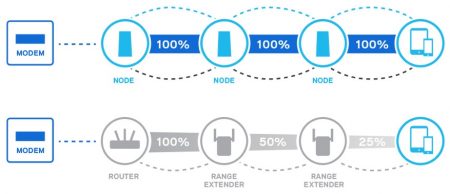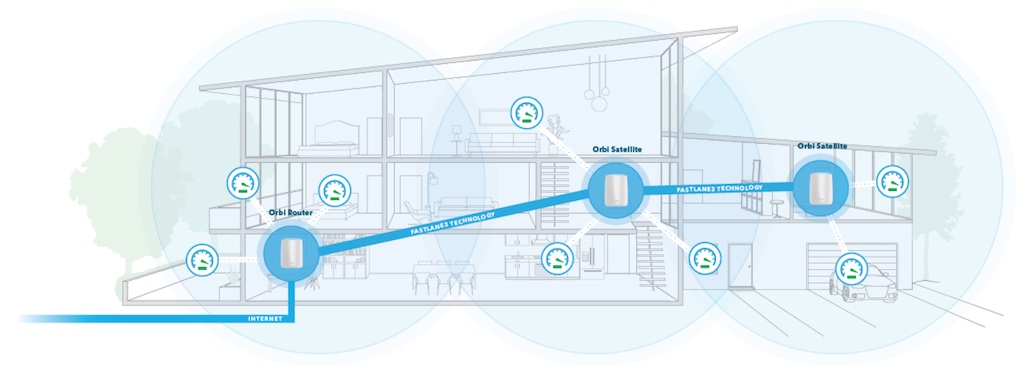
Hands up if you find yourself working from home these days. Hands up again if you find yourself struggling with Wi-Fi issues. I suspect there are a lot of hands being raised. The problem with working from home is that it can put a lot of demand on your Wi-Fi network. Throw other people in the house at the same time—and they’re undoubtedly hitting that same Wi-Fi network—and things can get frustrating. Many of those issues will go away if you upgrade to a whole home mesh Wi-fi system, which does a much better job with Wi-Fi coverage and traffic management.
Like many of you, I am working from home. However, I’ve been working from home on a full-time basis for over a decade, so that’s nothing new. What is new is my wife also working from home. That means another workstation, set up to remotely access the PC sitting on her desk at work. It also means regular video meetings. At the same time, my three teenagers are home. They’re doing classes online. They are also spending an extraordinary amount of time streaming video, and playing games online. Despite the extreme demand on our Wi-Fi, there have been no hiccups. No lag, no stuttering, no buffering, and no complaints about slow speeds.

We have a decently fast internet connection (500Mbps), but I believe the real hero has been our mesh Wi-Fi system. Two years ago I wrote about how the move from a high-powered router to a mesh system resolved my home theatre streaming issues. I’m pretty sure that if we hadn’t made that move then, the wheels would be falling off our home Wi-Fi bus under the current circumstances.
Whole home coverage
The first big advantage of a mesh wi-fi system is whole home coverage. With a base router and nodes placed around your home (the number depends on your square footage and layout), Wi-Fi dead spots are eliminated. That is really useful now, if you’ve been sharing space for weeks and find yourself seeking out quiet rooms or corners to work from.
Mesh makes for snappier performance
Mesh Wi-Fi systems excel at reducing latency, which can be a killer when you’re working from home. Remote access to a PC is frustrating if there is lag. Video meetings are a nightmare when there’s a delay involved. No-one like waiting for a web page to load.
With a standard router, the further away a connected device is, the lower the connection quality. That means a higher error rate, which means data needs to be resent. Speed drops off significantly, and that also means the device is monopolizing the router for longer. This causes delays when other devices try to communicate with the router.

In other words, all the devices on your Wi-Fi network are fighting for bandwidth and traffic processing by the router, but they’re forced to take turns.
With some of those devices almost always located in an imperfect location with poor signal strength, they are making the congestion even worse.
 Mesh systems use nodes that reduce the distance between a connected device and a Wi-Fi access point. That means a stronger connection, which means a faster data transfer rate is possible. So the device will be spending less time hogging the available bandwidth. That reduces latency for everyone who’s connected. A mesh system will also route a connection to a less busy node where appropriate, to optimize performance.
Mesh systems use nodes that reduce the distance between a connected device and a Wi-Fi access point. That means a stronger connection, which means a faster data transfer rate is possible. So the device will be spending less time hogging the available bandwidth. That reduces latency for everyone who’s connected. A mesh system will also route a connection to a less busy node where appropriate, to optimize performance.
When there are multiple people in video meetings, or gaming, or watching TikToks—along with other connected devices like cameras, smartphones, and smart speakers—the mesh system’s traffic management strength will really shine.
What issues won’t mesh fix?
Mesh Wi-Fi systems are pretty amazing, and they’ve made a convert out of me. But they can’t fix everything.
The biggest variable outside of your router is your internet plan with your ISP. If your plan doesn’t offer high speeds, a mesh router is not going to be able to make your video stream any faster than that connection supports. Speed also means a limit on bandwidth, so if there are multiple people or devices all trying to get online the same time, a slow internet plan can become a performance bottleneck.
Do mesh routers play nice with smart home devices?
Before you invest in a mesh Wi-Fi system, you may have heard about connectivity issues with smart home devices. Now is probably a good time to speak to that.
The root of the issue is that mesh Wi-Fi uses a single SSID (network name) for both the 2.4GHz and 5GHz bands. However, many smart home devices are equipped with only 2.4GHz Wi-Fi support. That means the potential is there for the device to fail to connect to the Wi-Fi network because it can’t find a specifically 2.4GHz SSID. If the smart device requires setup using a mobile app, and the smartphone or tablet is connected to the 5GHz band, there can also be a problem.
The reality is that in most cases, it’s a non-issue. Developers are well aware of the challenge (it pre-dates mesh systems since people often use a single SSID with standard Wi-Fi routers as well). Most devices have connectivity that’s robust enough that they can actively detect and connect to the mesh router’s 2.4GHz radio. Many also act as their own Wi-Fi access point during setup so a smartphone can easily connect to them first.
I’ve been using a Netgear Orbi mesh router for about two years now. During that time, I have tested dozens of smart home devices, and my house is full of them permanent installations—including cameras, a thermostat, a scale, air quality monitors, multiple lighting systems, a door lock, a doorbell cam, connected photo frames, plus untold smart speakers and streamers. I’ve rarely had a connectivity issue during setup. It just works seamlessly, as it should. The few times I did have an issue, doing the startup process a second time resolved whatever problem was there.
In a worst case scenario, there are easy and inexpensive (if kludgy) solutions. The most common is to buy an inexpensive 2.4GHz-only router or extender, connect it to the mesh network but give it a different SSID and connect the stubborn smart home devices to that.
Stop pulling out your hair, and embrace mesh

Working from home (especially when kids are also home all day) is all but guaranteed to push your Wi-Fi network to its limit. Video streaming, online gaming, remotely accessing an office PC, and participating in a video conference—all at the same time—is extremely demanding on a Wi-Fi router.
Make the switch to a whole home mesh system and you’ll see the difference immediately. The obvious advantage is a solid Wi-Fi signal all through your home, but in the background a mesh router is doing a lot of heavy lifting that ensures all those demands are met. The result is consistently smooth, stable, and responsive Wi-Fi for everyone, whether they are working from home, taking an online class, streaming a 4K movie, or playing their favourite online video game. If you want to enjoy fast performance, also consider upgrading to Wi-Fi 6.
Images courtesy of Linksys, Netgear, and TP-Link




I have a couple of wi-fi routers around the house and they work but not as well as I would like. I was thinking about running cables but that involved a lot of drilling. Mesh wi-fi is probably a better solution I should look into.
Whenever I have to replace my router, I will be upgrading to mesh wi-fi. Maybe I can stop using the powerline adaptor for the devices with ethernet on the 2nd floor of my home and use their built-in wireless connections
Comments are closed.